Holiday shopping – is it really busier than other times of year?
Understand where around the country holiday shopping is a big deal and where it’s just business as usual according to commercial vehicle data.

In “Influencing the Future of State Freight Plans,” Dan Andersen, Principal Practice Lead at Cambridge Systematics spoke about the capabilities of the LOCUS platform and Altitude by Geotab’s contextual insights. Dan showcased the potential of LOCUS for studying freight movement and keeping users informed via Altitude by Geotab’s integrated contextualized insights. The session provided glimpses of how transportation data as a whole can be harnessed to enhance truck parking and electric vehicle (EV) charging infrastructure on a state-by-state basis.
States must develop strategic freight management plans every four years, as mandated by the U.S. Department of Transportation. Their plans must factor in 17 different requirements, including but not limited to current trends, truck parking assessments, supply chains, multi-state compacts and delay mitigation strategies. States are provided funding from the federal government in exchange for the submission of a comprehensive freight strategy that assesses all 17 of the requirements and includes plans for how the funds will be used.
In this session, Dan highlighted how Cambridge Systematics helps bridge the data gap that state departments need to develop a suitable freight management strategy. Since 1972, Cambridge Systems has innovated solutions that enable organizations to easily make sense of intricate vehicle insights, helping them create smarter, more efficient transportation plans. With the development of their freight planning and analytics tool, LOCUS Truck, Cambridge Systematics allows departments to visualize holistic transportation data and study the functionality of existing transportation networks. LOCUS Truck was created using Altitude by Geotab’s extensive commercial vehicle dataset, equipping the platform with the latest and most accurate insights available.
The use of this data within LOCUS Truck is instrumental in planners’ ideas to build smarter interregional road systems. Deep insights about vehicle travel, vehicle types and parking trends help organizations lay the foundations of their freight movement strategies by providing them with accurate, tangible figures that indicate areas of improvement in the grid. Once states have used these insights to assess their region’s transportation network, they can begin installing new transportation infrastructure solutions to remedy any inefficiencies indicated by the data.
The presentation also provided an intriguing use case for truck parking data in the state of New Mexico. By studying current public and commercial parking lots, setting up zones and integrating Altitude by Geotab data within LOCUS Truck, leaders can gain a solid understanding of where current parking infrastructure stands.
With LOCUS Truck’s advanced insights, planners are also able to view metrics on a site-by-site basis, allowing them to see when the busiest times of the day are for parking, typical capacity limits and what industries or vocations the vehicles are usually associated with. Stop time distributions are another valuable metric that indicate how long vehicles are typically at rest and how trips are most commonly broken up. Using this information, state officials in New Mexico can visualize the best areas for new heavy-duty truck lots.
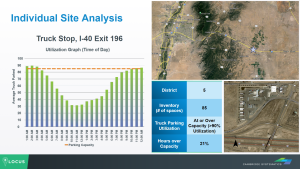
A sample screen capture of the New Mexico truck parking analysis.
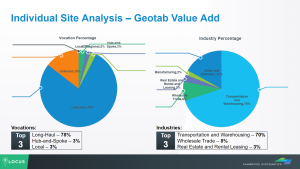
A vocational breakdown using Altitude by Geotab insights.
In addition to creating better truck parking opportunities, it’s also important for states to build more EV charging infrastructure. Given the recent interest in sustainability and commercial fleets going electric, Dan took time to highlight how vehicle movement data can be used in identifying choice opportunities for corridor electrification.
Increasing the number of vehicle charging stations helps encourage more companies to electrify their commercial fleets. In the state of Colorado, another use case was presented that demonstrated how origin and destination data could be leveraged during the selection process of new public charging locations. These would be needed to support in-state businesses making “middle mile” trips that want to convert their fleets to electric trucks. From the Denver metropolitan area northward to Fort Collins and southward to Colorado Springs, counties in between were found to regularly see vehicle trips in the 75-125 mile range before having minimum stop times of eight hours. Similar findings were also discovered along the northeast corridor from Grand Junction toward Rifle and Glenwood Springs.
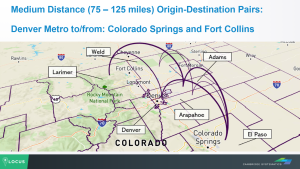
Demonstration of the regional analysis for Denver Metro to/from Colorado Springs and Fort Collins
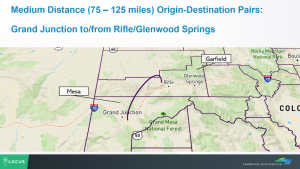
Demonstration of the regional analysis for Grand Junction to/from Rifle/Glenwood Springs
This data indicated that along the I-70 and I-25 corridors that see the heaviest freight traffic in Colorado, substantial opportunities exist to implement new EV charging stations. By building these new kinds of infrastructure, the state of Colorado can position their cities to support greener freight movement.
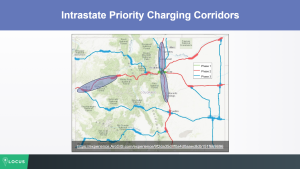
The optimal corridors to place new EV charging infrastructure (based on the study’s results)
By combining the capabilities of LOCUS with the breadth of Altitude by Geotab’s data, there is tremendous value available for state organizations as they plan new freight infrastructure. Prior to transportation analytics, planners and modelers were largely in the dark about how to most efficiently move freight. Now, with a wealth of deeper insights available, departments can use data to create truly comprehensive plans for safer, smarter and more sustainable transportation systems.
Interested in learning more about the LOCUS partnership or how Altitude by Geotab can support upcoming state freight plans? Contact us to discover how our accurate and contextual insights can help your state develop smarter strategies.